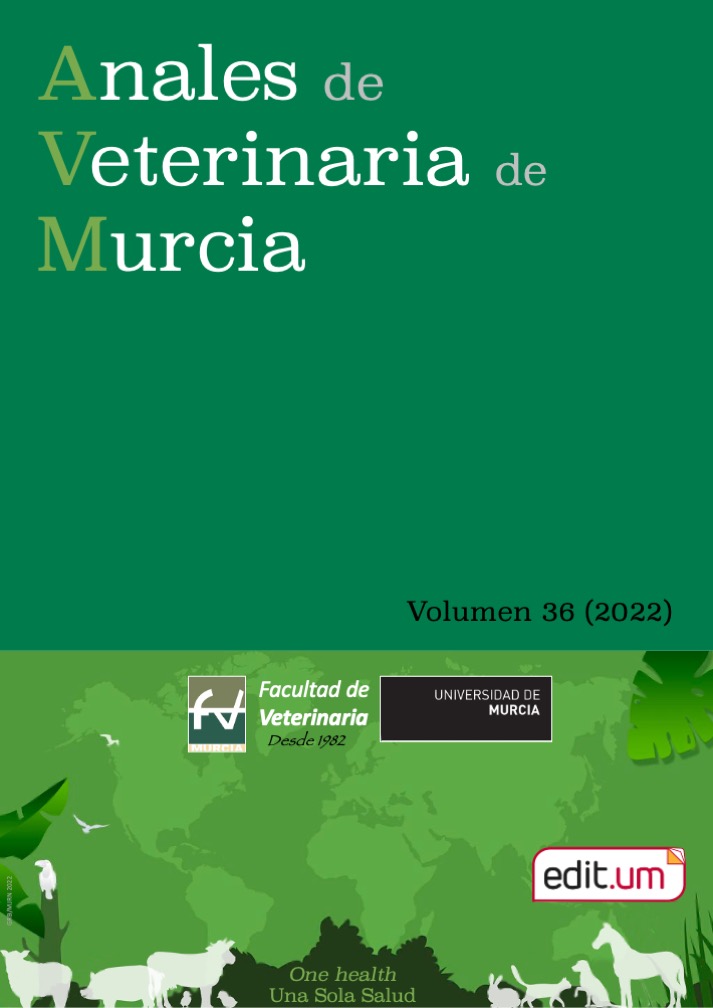CAPRINE TUBERCULOSIS: LESIONAL STUDY AND ITS RELATIONSHIP WITH THE TYPE OF DIAGNOSTIC REACTION
Abstract
Some regions of Spain have control and eradication programs to fight against goat tuberculosis. These official programs are based on a type of diagnosis that relays on cellular immunity (Intra dermal tuberculin test and IFN-γ release assay), however, there is a humoral type of diagnosis (serology) that could be useful as an ancillary test for the detection of animals with a predominant type of humoral response. Those goats are related to a more advanced phase of the disease and they can spread the bacteria in an easier way causing a persistent infection on some farms. Since these tests are based on the immunopathological process suffered by the animal, it is of our interest to understand better the regulation of the immune response at a systemic and local level. In this study, 23 goats were taken, 10 of which were positive only to cellular immunity-biased tests and the other 13 only positive to humoral-biased tests. From the macroscopic visualization of the lesions, samples were taken to perform 3 different studies: the histopathological one where microscopic lesions were classified as closed or opened. For the etiological study, the Ziehl Neelsen stain was carried out, and finally, for the study of the different lymphocyte families separately, immunohistochemical staining was performed. The objective was to find the existing relationships between the type of diagnostic test and the different studied parameters. The results showed that there was indeed a significant association between a cell-type diagnosis, with closed-type lesions, on the other hand, the association between a humoral-type diagnosis with open-type lesions (more infective ability), with a more significant presence of B lymphocytes as well as regulatory T lymphocytes in the lesion, a reason that meets our hypothesis that these cells are found in a higher number in more advanced stages with chronic inflammation processes.
Downloads
References
Balseiro, A., Gortázar, C., & Sáez, J. L. (2020). Tuberculosis animal: una aproximación desde la perspectiva de la ciencia y la administración. In Ministerio de Agricultura, Pesca y Alimentación. Secretaría General Técnica. Centro de Publicaciones.
Bezos, J., Álvarez, J., Romero, B., Aranaz, A., & Juan, L. de. (2012). Tuberculosis in goats: Assessment of current in vivo cell-mediated and antibody-based diagnostic assays. Veterinary Journal, 191(2), 161–165. https://doi.org/10.1016/j.tvjl.2011.02.010
Conserjeria de Agua Agricultura Ganadería Pesca y Medio Ambiente. (2018). Protocolo normalizado de trabajo para la ejecución de los controles del programa de erradicación de tuberculosis caprina en las explotaciones caprinas de aptitud lactea de la región de murcia.
García Marín, J. F. (2010). Tuberculosis caprina: diagnóstico. Pequeños Rumiantes, 11, 25–33.
Larson, R. P., Shafiani, S., & Urdahl, K. B. (2013). Foxp3+ regulatory T cells in Tuberculosis. Advances in Experimental Medicine and Biology, 783, 165–180. https://doi.org/10.1007/978-1-4614-6111-1_9
Matthews, J. G. (2016). Diseases of the goat (pp. 258–274). Wiley Blackwell.
Neill, S. D., Bryson, D. G., & Pollock, J. M. (2001). Pathogenesis of tuberculosis in cattle. Tuberculosis, 81(1–2), 79–86. https://doi.org/10.1054/tube.2000.0279
O’Brien, A., Whelan, C., Clarke, J. B., Hayton, A., Watt, N. J., & Harkiss, G. D. (2017). Serological analysis of tuberculosis in goats by use of the enferplex caprine TB multiplex test. Clinical and Vaccine Immunology, 24(2), 7–11. https://doi.org/10.1128/CVI.00518-16
Pesciaroli, M., Alvarez, J., Boniotti, M. B., Cagiola, M., Di Marco, V., Marianelli, C., Pacciarini, M., & Pasquali, P. (2014). Tuberculosis in domestic animal species. Research in Veterinary Science, 97(S), S78–S85. https://doi.org/10.1016/j.rvsc.2014.05.015
Rao, M., Valentini, D., Poiret, T., Dodoo, E., Parida, S., Zumla, A., Brighenti, S., & Maeurer, M. (2015). B in TB: B Cells as Mediators of Clinically Relevant Immune Responses in Tuberculosis. Clinical Infectious Diseases, 61(Suppl 3), S225–S234. https://doi.org/10.1093/cid/civ614
Sanchez, J., Tomás, L., Ortega, N., Buendía, A. J., del Rio, L., Salinas, J., Bezos, J., Caro, M. R., & Navarro, J. A. (2011). Microscopical and Immunological Features of Tuberculoid Granulomata and Cavitary Pulmonary Tuberculosis in Naturally Infected Goats. Journal of Comparative Pathology, 145(2–3), 107–117. https://doi.org/10.1016/j.jcpa.2010.12.006
Seva, J., Menchén, V., Navarro, J. A., Pallarés, F. J., Villar, D., Vásquez, F., & Bernabé, A. (2002). Caprine tuberculosis eradication program: An immunohistochemical study. Small Ruminant Research, 46(2–3), 107–114. https://doi.org/10.1016/S0921-4488(02)00174-8
Wangoo, A., Johnson, L., Gough, J., Ackbar, R., Inglut, S., Hicks, D., Spencer, Y., Hewinson, G., & Vordermeier, M. (2005). Advanced granulomatous lesions in Mycobacterium bovis-infected cattle are associated with increased expression of type I procollagen, γδ (WC1+) T cells and CD 68+ cells. Journal of Comparative Pathology, 133(4), 223–234. https://doi.org/10.1016/j.jcpa.2005.05.001
Welsh, M. D., Cunningham, R. T., Corbett, D. M., Girvin, R. M., McNair, J., Skuce, R. A., Bryson, D. G., & Pollock, J. M. (2005). Influence of pathological progression on the balance between cellular and humoral immune responses in bovine tuberculosis. Immunology, 114(1), 101–111. https://doi.org/10.1111/j.1365-2567.2004.02003.x
Copyright (c) 2022 Servicio de Publicaciones, University of Murcia (Spain)

This work is licensed under a Creative Commons Attribution-NonCommercial-NoDerivatives 4.0 International License.
Creative Commons Attribution 4.0
The works published in this journal are subject to the following terms:
1. The Publications Service of the University of Murcia (the publisher) retains the property rights (copyright) of published works, and encourages and enables the reuse of the same under the license specified in paragraph 2.
© Servicio de Publicaciones, Universidad de Murcia, 2019
2. The works are published in the online edition of the journal under a Creative Commons Attribution-NonCommercial 4.0 (legal text). You can copy, use, distribute, transmit and publicly display, provided that: i) you cite the author and the original source of publication (journal, editorial and URL of the work), ii) are not used for commercial purposes, iii ) mentions the existence and specifications of this license.

This work is licensed under a Creative Commons Attribution-NonCommercial-NoDerivatives 4.0 International License.
3. Conditions of self-archiving. Is allowed and encouraged the authors to disseminate electronically pre-print versions (version before being evaluated and sent to the journal) and / or post-print (version reviewed and accepted for publication) of their works before publication, as it encourages its earliest circulation and diffusion and thus a possible increase in its citation and scope between the academic community. RoMEO Color: Green.




